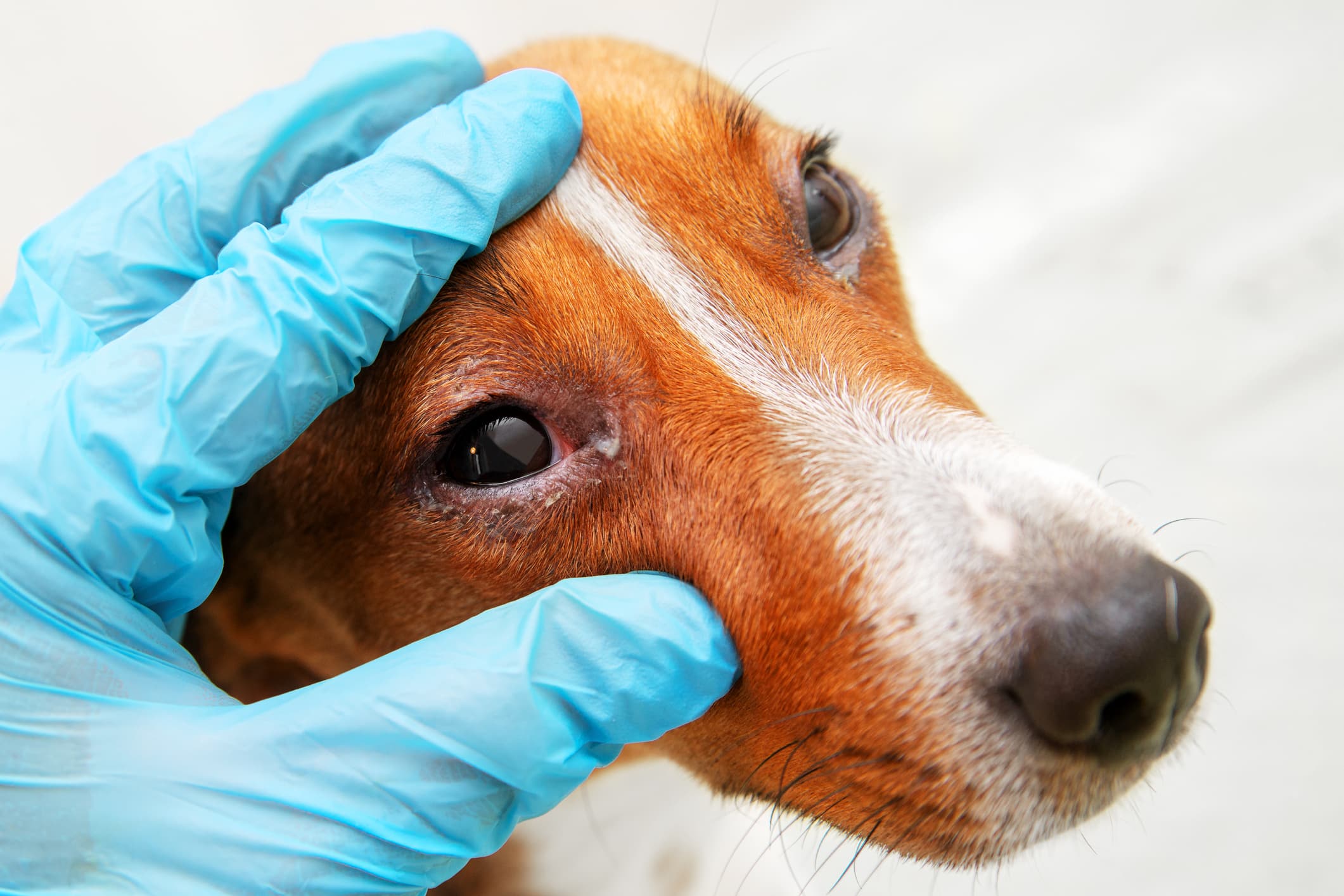Dog eye infections can be extremely painful and need immediate attention. There are lots of tell-tale signs to help determine whether it’s dog eye allergies vs. infection and what the appropriate treatment should be.
Your dog may not be able to tell you he has a sore eye, but here are some very obvious clues that he may be suffering from a dog eye infection:
- Squinting or keeping the eye completely closed. This is called Blepharospasm.
- Constant pawing at the eye, or rubbing the eye on the ground or couch.
- Your dog is sensitive to being approached or touched near the affected eye.
- Redness and signs of inflammation around the inner eyelids/mucosal tissue are signs of conjunctivitis.
- A redness around the iris in the “white of the eye” is referred is an episcleral injection caused by congestion of the episcleral vessels.
- Swollen conjunctival tissue is called chemosis.
- Excessive discharge from the eyes. It could be clear or, if there’s severe infection, it will likely be discolored, pus-like material. This is called epiphora.
- A general reddening/inflammation in the interior of the eye is known as Uveitis.
Dog eye infection treatment: when to see a vet
Treatment depends on the diagnosis. Routine treatment for an ulcer or bacterial infection is antibiotic eye drops or ointment. More severe infections require a course of antibiotics in addition to a topical ocular medication.
Bad doggie news: Your dog will not be impressed, because a head cone is usually required to keep the area paw-free from scratching. Fortunately, there are lot of more comfortable soft options that will do the job instead of a hard-plastic cone.
How to treat dog eye infections at home
Although there are no dog eye infection treatments at home, there’s a lot a pet parent can do to prevent dog eye issues.
Use these tips to prevent dog eye infections:
- Keep the eyes and the surrounding hair and skin clean. Keep nails short and dull so they don’t inadvertently scratch the eye area. And avoid other pets who may scratch and cause trauma, too.
- Special canine eye lubricant gels are good preventives to use prior to and after outdoor activities to help avoid dust and foreign material getting into the eye and also before a bath to avoid a shampoo irritating the eyes. Ask your veterinarian for recommendations.
- Don’t allow your dog to dig randomly in the yard or in areas with lots of low bushes and plants that could cause trauma to the eye area.
“We see a lot of eye trauma due to plant branches, thorns, foxtails and other areas where dogs are investigating narrow places,” cautions veterinarian Dr. Chad Maki, BVM&S, of Huntington Beach, California.
If your dog is prone to allergies, keep an antihistamine such as over the counter Benedryl (diphenhydramine) on hand. Dr. Maki recommends 1mg/lb., up to 50mg per dose, up to every eight hours.
Eye infections can also be controlled if you avoid interaction with dogs with any signs of an upper respiratory infection or eye irritation. Also, step up your pooch’s regular grooming routine to ensure the eye area is always clean.
It’s a good idea to add a specially formulated eye wash and eyelid cleansing pads to your grooming kit. Bausch + Lomb well known for human eye care products have launched a range called Project Watson (https://www.bausch.com/products/dog-care/eye-care-for-dogs/ ) specially for dogs inspired by a terrier-mix named Watson. The eye wash is a gentle, pH-balanced multi-purpose solution formulated to help cleanse irritants and debris from dogs’ eyes and the eyelid wipes are pH-balanced, pre-moistened textured wipes with micellar technology that cleanses and hydrates around the eyes to help remove excess buildup.
If your dog has a very active outdoor social life that includes hikes and beach days, it’s a good idea to keep cleansing pads in your kit and wipes down even before you get home. Your dog will thank you with grateful kisses.
Dog eye allergies vs. infection
“Determining whether it’s an infection or an allergy can be a tricky diagnosis for a pet parent,” explains Dr. Maki. “If the inflammation is severe, the eye seems to be painful, and there is mucopurulent discharge (pus discharge), then most likely it’s an infection.”
Dr. Maki points out that if symptoms are milder, even if there is clear discharge, but the eye doesn’t seem painful, then it could be either an infection or an allergy. Allergies usually have other symptoms, too, such as sneezing, an obviously itchy skin (pruritus), constant paw-licking, ear-scratching and irritated anal glands.
“Further, if the allergy symptoms are year-round, the issue could be an atopic dermatitis. It’s important to check that the issue isn’t food related, too. Thus, with so many variables, it’s best to let a veterinarian make the final diagnosis,” he adds.
Dog eye infection diagnosis
Because there is such a wide range of causes of eye infections, a veterinarian will typically administer a topical anesthetic to relieve pain and then proceed with a more thorough ocular exam.
Typical dog eye infection tests include:
- The Schirmir Tear Test (STT) measures the amount of tear production. If it is low, it could be a case of keratoconjunctivitis sicca (KCS), or dry eye. This is an autoimmune condition that attacks the patient’s own tear glands and can be treated with topical ocular immunosuppressants.
- An examination with an opthalmoscope allows the veterinarian to see the back of the eye through the pupil and also to look for any misplaced hairs or eyelashes or foreign material such as a foxtail that could be caught under the third eyelid, as well as any sign of a tumor.
- A test to read the intraocular pressure will determine if it’s a more serious condition such as glaucoma.
- A fluoresceine stain will determine if there’s a corneal ulcer present, which is more serious and needs to be treated and monitored closely for resolution.
- Sometimes a sample of the discharge is sent away to be analyzed.
More serious conditions such as glaucoma, a luxated lens, melting ulcer or foreign body penetration, require immediate referral to an ophthalmologist, as fast surgical intervention may be able to rescue the eye.
Dogs often contract eye infections from other dogs. Common dog eye infectious are caused by Mycoplasma bacteria and a range of viruses such as adenovirus, distemper virus, herpesvirus, parainfluenza virus, pneumovirus, respiratory coronavirus and influenza A.
Learn more about what causes eye infections in dogs.






